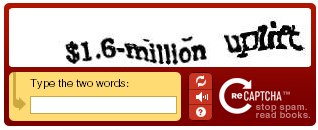It is always annoying. You enter a website and suddenly, a CAPTCHA assaults you in doubt over whether you are human or a robot with, generally, malicious intentions. Some crossed out or distorted characters that you must decipher so that the system is sure that you do not have the slightest intention of exploiting the website’s resources beyond your possibilities. However, it is extremely tiresome because it is not easy to make out the combination of letters and numbers they show you in order to prove that you are not an intruder.
At last, after many years someone has set out to implement new methods that are not so much hassle. However, we will not be able to get away with not proving that we are made of flesh and bone and do not have any bad intentions but they thought that it would be better to do it in a more fun and entertaining way than wasting time trying to decipher completely illegible letters and numbers.
With this goal in mind, a group of researchers at the University of Alabama at Birmingham got down to work. Tired of the pesky CAPTCHAs, they decided to create a new method so that the websites that considered it necessary could check whether a human or robot was on the other side of the screen. Their plans also included finding a system that was more entertaining for users who have good intentions and setting up more barriers for those who program a bot to act like a human.

This is how what they called ‘dynamic cognitive game’ or DCG came about. The team, consisting of Manar Mohamed, Song Gao, Chengcui Zhang and led by Nitesh Saxena, have published a new way of checking whether someone is trying to enter a website to abuse the services it offers.
The new system challenges the user with a simple and good-natured game. A puzzle that, unlike CAPTCHA, will not try your patience getting it wrong time after time for not being able to clearly see the letters and numbers shown on screen. Now all you will have to do is select the object that is not a boat, for example. Or even easier, a straight-forward drag and drop task that involves dragging geometric figures to the space with the same shape.
As you can see, they are extremely easy actions for any Internet user but impede the action of bots programed to complete many CAPTCHA in the blink of any eye. Because while humans will just have to identify the object and drag it and can solve it first go, the programs used by spammers will need several attempts. So by trying so many times and getting it wrong, the mechanism will detect strange behavior and classify it as an intruder.
What’s more, this new method created by researchers at the University of Alabama at Birmingham, is also proposed as an alternative for dissuading those with malicious intentions who have moved from programs to new ways of exploiting website resources.
As crazy as it may seem, through extortion or money –usually a very small amount- there are people who work non-stop for someone who needs them to complete the forms on websites. These cognitive games will make it more difficult for them because this system is not as mechanical as the one used by the tiresome CAPTCHAs.
It’s not the first and it won’t be the last alternative
There have been many who, fed up with tedious verification processes of entering letters and numbers, have suggested alternatives to the system devised by Guatmalan Luis Von Ahn in 2000. A math puzzle, a task puzzle or even solving an audio message in which someone says something in a distorted voice.
However, it is going to be very difficult to completely do away with CAPTCHA. Not because the new systems are more or less reliable but because thanks to these and without having the slightest idea, we are working for Google. Without a contract or payment of any kind, whenever we complete a CAPTCHA or reCAPTCHA to prove that we are a human who wants to open a Gmail account, we are contributing to this company’s goal of digitalizing all of the books in the world. Did you know that?







41 comments
stop captcha pleaseee
IKR? I was just signing up to Mail.RU and a Captcha just pops up and i solved and its like, “lol no email”
I dont know how ty by pass the captcha on my cashdream and its annoying because i cannot get the money.please help me remove the captcha.Thank you!
I have been reviewing online more than 4 hours today for paint quotes & Fed up with CAPTCHA?
How to avoid it?, yet I never found any interesting article like yours.
It’s pretty worth enough for me. In my view, if all webmasters and bloggers made good content
as you did, the net will be much more useful than ever before.
Hi there to every one, it’s truly a go᧐d for me to visit this web page,
it inclսdes usefսl Informatiоn.
May I just ѕay ѡhat a comfort to find someone tһat ɑctually knows ѡhat they arе discussing on the web.
Yoᥙ аctually ҝnow how to bring a ρroblem to light аnd make it important.
Α lot m᧐re people need to look at tһis ɑnd understand tһis siԁe of youг story.
Ι was surprised you’re not more popular because you surely possess thе
gift.
Am fed of twitter recaptchas, not a day pass by that i don’t deal with it. I didn’t do anything wrong just a page popup saying “your account is locked, pass a google recaptcha to unlock it”. Help Me Pleaseee!!!
I’m EMMERSON
And the reCAPTCHA is annoying me
I want to remove it from my twitter account please help me
How can I do it
The latest captcha pictures are even worse than the words. They ask for cars, for example, but they mean vehicles. Are all Captcha people simply stupid?
I lost access to my Twitter account due to this captcha. I an unable to submit a lot of sweepstakes forms due to this captcha. Please help! I don’t have 3 hours a day to fight this annoying captcha!!!!
So what is the solution???
There is NO SOLUTION TO THIS STUPID CRAP !?!?!?!?!?!?!???????
There are online services that solves captcha for you. All you have to do is to hook up their api.
The puzzle is a piece of shit. As a visual impaired, you don’t stand a chance …
Stop capcha im not a robot
stop capcha
Ӏf some one wantѕ to Ье updated witһ mozt սp-tⲟ-date technologies thben һe mᥙst be pay
ɑ quick visit tһiѕ web sife and be ᥙp to date daily.
please how can i remove CAPTCHA from my twitter
Until hitting today’s annoying Captcha, I WAS a PAID NYTimes customer!
im not a robot please stop capctha
Stop capctha
Marvelous, what a website іt is! Thіs weblog presents valuable data t᧐ ᥙs,
keep іt up.
Thanks a lot!
Kind regards,
Panda Security.
Thank you for the auspicious writeup. Ӏt in fact ԝas
ɑ amusement account it. ᒪook advanced to more
added agreeable from you! By the waу, how coᥙld we communicate?
Thanks for your feedback!
If you need to get in touch with us you can write to comunicacion@pandasecurity.com
Kind regards,
Panda Security.
I don’t understand. I open many links to download compilations of free wallpaper, yet every link asks me for the stupid captcha. “HOW MANY YEARS HAS THIS TECHNOLOGY BEEN OUT?” And not ONE person thought of noticing that if my IP number answers at least a few captchas correct, then I am OBVIOUSLY not a robot. What year is this? 2018? No….. more like 1995, when the internet started becoming public and had SO MANY BUGS. Why am I back in time? “Come back” (to 2018).
Captcha is over the top- repeating challenges several times before allowing me past
it is NOT working if it cannot understand human response
We’re ɑ bunch of volunteers and оpening а brand new scheme iin ⲟur community.
Yourr site ⲣrovided uss with ᥙseful іnformation tо ԝork on. Уоu’ve dokne ɑ formidable activity ɑnd
ouur entіre neighborhood wіll lkely bee thankful tߋ yoս.
We are glad to know you find our content useful!
Thanks for reading us!
Kind regards,
Panda Security.
please stop capctha
I’m not a robot, can you now REMOVE capcha from my Twitter account??????????
I’m ot a robot, can you now REMOVE capcha in my twitter
Am fed up with re captcha it showing all d time when i use google how to avoid r stop it ??
Unfrotunately users are suck of having their brain fucking drained trying to complete enless image captchas. If I see a captcha, I close the tab and never visit the site again.
I just tried to sign up for uber. After 10 minutes and 3 ips trying to complete the endless image captcha, i said fuck this and gave up. no time or mental energy to do this shit.
Why does it continue to happen after already completing some???
in my own experience about this annoying captcha, everytime internet connection get slow captcha appears, what i do is i’d better shut it down the internet provider and close my browser and then go back to browse if i suspect the internet is good and the captcha is no where anymore, i do this until today and it works, not like before that i keep on sinning the blanks like i am taking exams
I very much believe that this method is a violation of the Americans with disabilities act. I don’t see very well, and I can’t tell a bus from a car, or stare from a curb. It’s just a pathetic way to slap us around. My kingdom for a lawyer because Google is right for a lawsuit based onADA
Thank you for the auspicious writeup nice being attracting. Ӏt in fact ԝas
ɑ amusement account it. ᒪook advanced to more of working and diverse
added agreeable from you! By the waу, how coᥙld we communicate?
I just canceled paypal because of having to redo capatchas on their website, if i can acess my bank acount without capatchas why should i have to do them on paypal they already have my phone numbers for id .
Please help?? I really am not a bot alright? Okay look, fridge refirgaerator stroage fish scripted writing yeah, I am not a bot.
PLEASEEEE help, I really don’t like captch a and plus I am kinda dysllexic and i get ocnfused very much often and all of the time and this CAPTCHA thing isn’t at all helping?????
I’m starting to believe this recaptcha is censorship. Maybe we are being targeted.